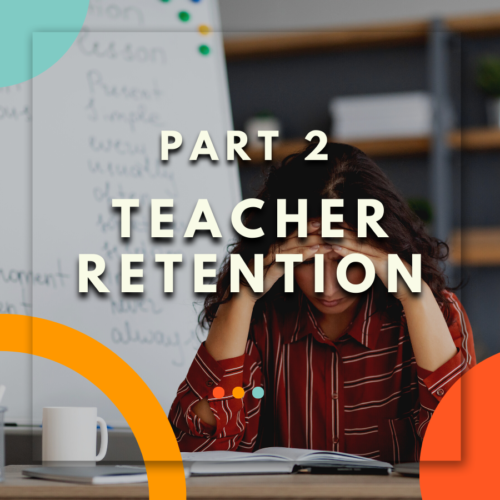States Addressing the Teacher Shortage, Part 1: Recruitment
States across the U.S. are considering solutions to address potential teacher shortages. While the extent of the shortage differs from state to state, teacher shortages are most severe in subject areas such as math, science, special education and English language development.
The source of teacher shortages is twofold: waning teacher recruitment and poor teacher retention rates.
 In March 2022, the National Center for Education Statistics (NCES) reported that 44% of schools were reporting teacher vacancies. Resignation is the leading cause of vacancies accounting for 51% of reported vacancies, and retirement is reported for 21% of vacancies. NCES Commissioner Peggy G. Carr cites the COVID-19 pandemic as a source for these shortages. Other reports note a variety of factors contributing to declining teacher recruitment and retention, such as working conditions, financial compensation and inadequate preparation and support for new teachers.
In March 2022, the National Center for Education Statistics (NCES) reported that 44% of schools were reporting teacher vacancies. Resignation is the leading cause of vacancies accounting for 51% of reported vacancies, and retirement is reported for 21% of vacancies. NCES Commissioner Peggy G. Carr cites the COVID-19 pandemic as a source for these shortages. Other reports note a variety of factors contributing to declining teacher recruitment and retention, such as working conditions, financial compensation and inadequate preparation and support for new teachers.
As turnover rates increase and recruitment decreases, schools are often forced to increase class sizes while decreasing student supports. In addition, many schools are left to fill vacancies with underqualified teachers, which also contributes to higher turnover rates.
Even as the number of college students receiving bachelor’s degrees doubled and continued to rise, the number of graduating education majors has substantially decreased throughout the country since 1970. The reasons for this migration away from the education field are varied and complex, but the solutions might be comparatively more straightforward.
Even as the number of college students receiving bachelor’s degrees doubled and continued to rise, the number of graduating education majors has substantially decreased throughout the country since 1970.
Reducing barriers to entry by providing financial incentives for initial education and training can support teacher recruitment. Receiving a college degree in education can be costly and can dissuade college students from pursuing teaching as a career path, especially given the lower salary rates compared to other college graduates. Providing financial incentives to offset the costs and debts assumed by aspiring teachers can increase recruitment. Financial incentives can include service scholarships, stipends for college students pursuing a career in education, as well as student loan repayment/forgiveness plans for educators. Scholarships are financial supports provided to students for tuition, while stipends are periodic sums of money given to students for general expenses (living, transportation and books, for example). Either of these incentives can encourage more students to pursue a degree and career in education.
Similarly, the prospect of state or local student loan repayment options may encourage college students to enter and remain in a teacher certification track. While policies providing these incentives can increase overall recruitment, research suggests these incentives are especially effective in targeted recruitment in hard-to-staff schools and subject areas as well as populations underrepresented in the state’s teaching profession.
State Examples:
Colorado provides a stipend to offset tuition costs for teacher candidates pursuing certification and employment at a rural school. The stipends are not to exceed $4,000 per student, and an eligible candidate must agree to teach in a rural school for two years. The state also provides stipends of up to $6,000 for rural teachers seeking alternative certification, certification as a special services provider, or further credentials to meet the needs of the school.
Minnesota requires the Office of Higher Education to establish a grant program to provide student teaching stipends to teacher candidates from low-income and underrepresented backgrounds, as well as teachers in high-demand fields and rural learners. The state also provides student loan repayment opportunities for such eligible in-service teachers as well.
Indiana provides scholarships to college students pursuing an education degree in special education or a high-need field. In the applications, candidates must submit in writing that they intend on applying to teach in the state, and if they are hired, agree to teach for at least three years.
Michigan is also currently addressing the financial barriers to student teaching. House Bill 6013 (2022) would establish a grant program for districts to pay student teachers $90 a day and provide a stipend to their mentor teachers. The bill passed the House in June and is awaiting discussion in the Senate.
An apprenticeship program is an industry-driven, high-quality career pathway characterized by on-the-job learning, classroom instruction, mentorship, and progressive wages.

The National Center for Grow Your Own’s David Donaldson speaking at the 2022 CSG East annual meeting
One of the most recent innovations in education training is the development of a teacher apprenticeship training model. Launched in 2020 by the state of Tennessee, the Grow Your Own model addresses local workforce needs and utilizes the community to build a sustainable talent pipeline. With today’s high demand for quality teachers, these programs can support recruitment and retention. According to the Regional Education Laboratory Southwest, well-executed Grow Your Own (GYO) program graduates often remain in the profession longer than typical beginning teachers in urban and rural schools. The Grow Your Own concept can take multiple forms, but fundamentally focuses on creating a local pipeline to support a school district’s teacher workforce.
Common approaches in Grow Your Own programs include:
- Career pathways offered to secondary students
- Pathways for existing education support staff to obtain education degrees and certificates
- Residency programs for community members interested in becoming educators.
Many states are developing and sponsoring new, sustainable talent pipelines to address teacher recruitment and retention. Examples are provided below.
Like apprenticeships, teacher residencies are a structured, alternative mode of entry into the education profession, modeled after medical residencies.
Candidates in teacher residencies typically already hold a bachelor’s degree, and training combines post-graduate courses with a hands-on internship in the classroom, with a certified teacher of record. Importantly, these programs also allow residents to earn income – either through wages or stipends – while participating in the program.
Residencies create an important pipeline to the profession that is especially effective at addressing shortcomings of traditional routes to the classroom, specifically recruiting diverse and shortage area teachers. In addition, teacher residencies are considered to be the “gold standard” for teacher preparation, and studies suggest student achievement increases when taught by a graduate of a teacher residency. While teacher residencies are often local, grow-your-own model initiatives, such as the Boston and Louisville teacher residency programs, states can also support the development of residency programs or adapt local models and frameworks for consideration at the state level.
In September 2022, the U.S. Department of Education announced the award of over $60 million in grants to address the teacher shortage. Among other considerations, the grants fund state and local development of sustainable pipelines, including teacher residencies. Awardees include The National Center for Teacher Residencies, which will develop 14 residency programs, ten of which are at Historically Black Colleges and Universities (HBCUs), across five states. State recipients include Louisiana and Missouri. By expanding teacher residencies, states can secure a more sustainable, targeted pipeline to address regional shortages.
State Examples:
Tennessee’s Teacher Occupation Apprenticeship is the first K-12 teacher apprenticeship program registered by the US Department of Labor. Apprentices will work in schools as paraeducators while working toward a bachelor’s degree. Upon graduation, apprentices will earn dual certification in a grade/subject level, and special education. The program builds on previous a previous model- the Clarksville-Montgomery County Teacher Residency Program. While Tennessee is the first state to formally have a civic sector apprenticeship for teachers formally registered by the Department of Labor, other states are funding and expanding grow your own educator pathways.
Utah established teacher and school counselor pipelines. The pipeline trains employed paraprofessionals, or other educator support staff, in cohorts to earn certification as a teacher. Additionally, these funds can be used to provide stipends for school counselor candidates enrolled in a bachelor’s or master’s degree program working as a counselor assistant or intern.
Delaware recently codified its financial support of teacher residency programs in the state. The bill directs the state Department of Education to develop grant programs for residency programs in partnership between schools and institutions of higher education. To be selected, applicants must, among other requirements, identify a plan to recruit residents from diverse backgrounds. Priority is given to applicants who commit to either to recruiting residents in critical shortage areas or placing residents in classrooms with a significant number of low-income or English learner students. Residents in the programs must teach in the state for at least three years.
Colorado requires the Department of Education to establish a teacher preparation pipeline framework to address the need for quality teachers. Teacher candidates are employed in the final program year, working under a teacher of record. In exchange for payment of their tuition (up to the last 36 credit hours), the teacher candidate is expected to commit to teaching in the same school district or charter school for three years after completing the program.
California recently expanded their support of the Teacher Residency Grant Program. The legislature appropriated $350 million to the Commission on Teacher Credentialling to provide grants to educational entities supporting teacher residencies. Grantees are required to match 80% of funds and can use up to $25,000to support each individual teacher.
In Washington, D.C., the Office of the State Superintendent of Education established a “Grow Your Own” Teacher Preparation Support Program that provides training, education and financial support for high school dual enrollment students, public high school graduates, and paraprofessionals to become licensed teachers in the District.
Montana provides grant funds for rural or reservation school districts impacted by the quality educator shortage. These funds are used to create career pathways into education, including school-based programs for current students.
Minnesota established a grant program for districts utilizing a Grow Your Own program to diversify the teaching workforce. Schools utilizing these funds must use 80% to provide scholarships or stipends to minority or American Indian school employees or affiliated community members. The grant can also be used to fund innovative programs seeking to help secondary students of diverse backgrounds prepare for and enter the teaching profession.
The New Mexico Department of Education provides scholarships to non-certified school employees demonstrating financial need who are seeking further education pursuant to earning a teaching certificate. In addition, the employee can request leave for education or examinations and, if necessary, utilize distance learning resources.
As states seek to address regional teacher shortages, focusing on entry and training can help increase recruitment without sacrificing teacher quality. By doing so, states are moving to address a decades-long downward trend in college graduates entering the teaching profession, and they are approaching the problem from many different directions. The Council of State Governments and CSG East will continue to analyze these approaches, pulling in the best research available and summarizing main themes for members.
This two-part series explores how states across the country have worked to address teacher shortages by improving both recruitment and retention. The series focuses on the following policy considerations:
Part 1: States could increase teacher recruitment by:
- Developing sustainable talent pipelines:
- Reducing financial barriers.
- Providing a greater number of on-ramps, such as apprenticeships and residencies.
Part 2: States could improve teacher retention by:
- Supporting career advancement opportunities for those in the education field, including career ladders and mentorship opportunities.
- Improving working conditions:
- Supporting administrator training and development
- Increasing teacher capacity by providing support staff and reasonable class sizes
- Creating avenues for educators to participate in school decision-making processes.





